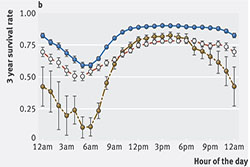Current questions
How can AI make doctors practice their best?
Since 2012 excitement around the applicability of AI [ to the practice of medicine, particularly its big-data-driven realization, has risen rapidly to heights not seen since the 1980’s. Beyond advancing the computational science underlying these AI efforts, the greatest challenge is finding how, when and where AI can enable clinicians to be as insightful, meticulous and engaged with their patients as possible. Whether the AI applications are in clinical workflow and efficiency, in diagnostic or therapeutic decision-making, we ask first where improvements are possible and which tasks are best assisted or fully automated. We also study how these applications and their underlying technologies are vulnerable to bias, error and adversarial attack. Because informed patients make the doctor-patient relationship more effective, we are also investigating how to provide them with diagnostic and therapeutic selection decision-support.
What is right drug for your patient?
When a patient is said to "fail" a pharmacological treatment, the grievous error of putting the treatment outcome on the patient's shoulders is dwarfed by the error of not recognizing that the reason for the outcome may be misdiagnosis. Not misdiagnosis in the sense of incompetent or negligent assignment of a diagnosis to a patient but the failure of clinical medicine to recognize that many individuals who are lumped together as having the same diagnosis because of shared symptoms, signs or laboratory findings have a pathophysiologically distinct disorder from others bearning the same diagnosis [Post-genomic diagnosis]. We've seen extreme examples of such misleading phenocopies in the Undiagnosed Disease Network where individuals can present with common findings but are ultimately found (using the right multidisplinary expertise &genomic sequencing [NEJM2019] ) to have a distinct rare disease. For individuals who do not respond to standard therapy, can we use the insights from all the public databases of drug structure, drug effects on the transcriptome, effects and side effects of closely related drugs, and contemporary "real-world" data from electronic health record and insurance claims databases? We are trying this not only as an academic exercise but also for clnical cases of no-other-resort.
When can observational data be used to complement or substitute for Randomized Controlled Trials (RCT)?
Most recognize that we cannot afford to run a RCT for every clinical question. This has inspired us and others to investigate the use of "Real World Data" (RWD) obtain from electronic health records (EHR) and insurance claims to evaluate drugs, clinical care and to drive discovery. Naive approaches are fraught, not least of which is the way EHR data reflect the judgement of thousands of clinicians and the vagaries of transducing the narrative text of records (Natural Language Processing—NLP) into codified concepts. Further, the way analyses are adjusted to be comparable and generalizable often allows highly variable and irreproducible results. Yet with care observational data can be used for a wide range of research applications.
How can electronic health records be used to understand a pandemic?
When the COVID19 pandemic struck in early 2020, we immediately realized the relevantce of our work on instrumenting the healthcare system for discovery and care to rapidly understand the clinical course of this disease. Within 30 days we had gathered an international consortium of volunteers across 9 countries and over 300 healthcare systems and demonstrated that now well-known constellation of coagulopathy, cardiomyopathy, renal failure and system-wide inflammation was obvious by the first day of admission. Since then the consortium continues to document how the care of patients with this infection varies by geography and time and how the post-acute course continues to evolve.
What is autism?
Doctors and researchers were much slower than parents to recognize that autism not only presents along a spectrum of severity but is a collection of distinct diseases each with its own morbidities. Recognizing these distinct disorders within this increasingly unhelpful broad label is essential for progress in developing the appropriate and specific treatments. We've explored the question of what is autism using methods ranging from functional genomics, epigenomics, to analysis of electronic medical records data, medical insurance claims data and genetic variation.
Why do some patients have amazingly good results from cancer therapy?
Although we are in the midst of a welcome revolution in cancer therapy, rare individuals do remarkably better than anyone else with the same treatment. Perhaps most strikingly, in some trials of treatments that have "failed" to show efficacy there are a few patients who have done very well. Why is that? To answer this question we have launched a people-medicine-powered study that we call NEER—Network of Enigmatic Exceptional Responders. We are studying their genomes, clinical histories, micobiome, immune profile and lifestyles in order to determine why they have had such an impressive response.
